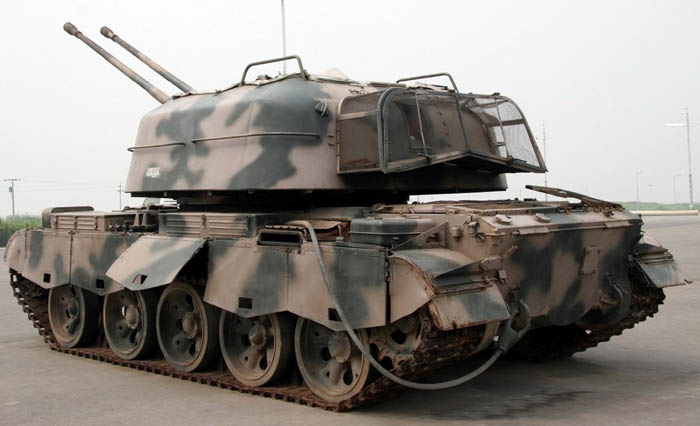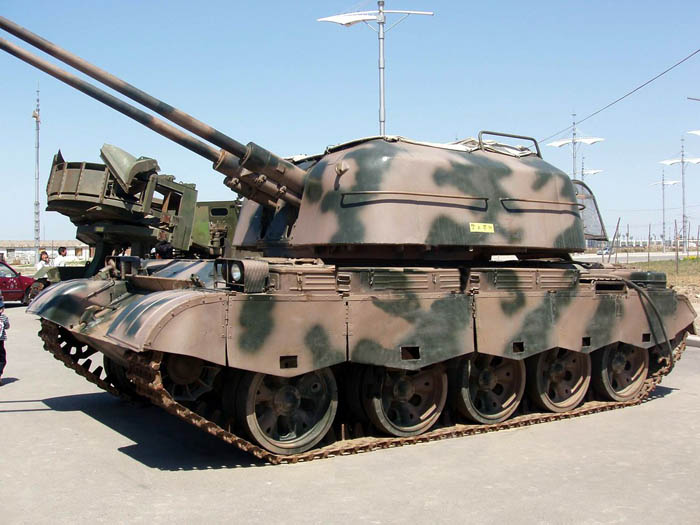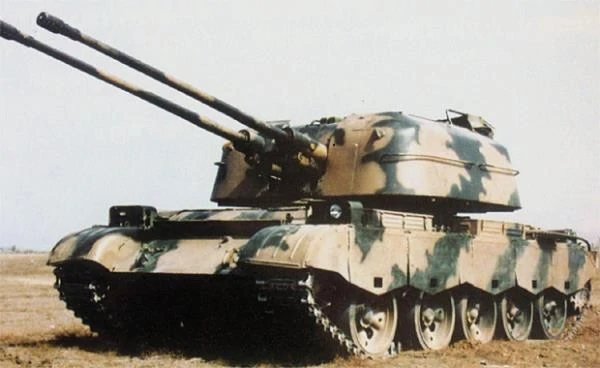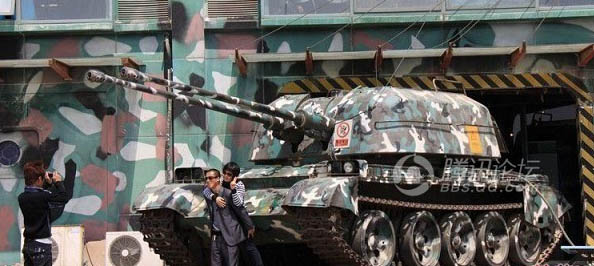The first P.L.A. SPAAG
The self-propelled anti-aircraft defense Type-80 was basically a Chinese ZSU-57-2 based on the domestic Type 69 main battle tank chassis. Its armament and turret was vey close to the Soviet model but when introduced in 1981 it was already obsolete, leadin to a cancellation of the production. There apparently one one prototype of this SPAAG built. The Type 80 self-propelled anti-aircraft artillery (SPAAA) was indeed developed in the 1980s for the export market, but was never exported so far. It stays in the inventory until the 1990s reclassifications and its new ordnance name became PGZ-80., however the PRC never imported the ZSU-57-2 directly, so its likely the type was captured and resold by a third party like Syria or the Czech Republic. But it was Iraq in that case:
The PRC was eventually approached by Iraq in the early 1980s to develop a copy of the ZSU-57-2 system and some were delivered to the PRC for reverse-engineering. This later led to the introduction of the Type 80, which is essentially a twin-barrel Type 59 AAA gun mounted on a Type 69-II tank chassis. The SPAAA has no fire-control system and can only be used in clear weather. The weapon system saw some limited service with the Iraqi Army during the 1980s Iran-Iraq war and the 1990s Gulf War.
Design of the type 80
Hull
As the Chinese equivalent of the Soviet-designed ZSU-57-2 "Sparka" (the pair) this SPAAG was originally based on a modified T-54 tank chassis, but in the Chinese case, the obvious choice was to take the Type 69-II Main battle tank chassis and modify it to fit the new turret. The main difference between the Chinese system and the Soviet system is the chassis. While the Soviets developed a lighter chassis with only four wheels in the tracks, the Chinese designs differs in having five wheels. As the chassis of the vehicle is virtually identical to Chinese Type 69, it has the same five wheels configuration as the MBT, with the same distance between the first and second wheel. The Chinese system was developed during the 80s but had the same problems as the Soviet system. The armament was of acceptable quality, but the tower was extremely slow, and by the 1980s, the system was hopelessly outdated.The Type 80 being generally similar to the Soviet ZSU-57-2, a T-54 carrier for the old S-60 57mm AAA gun developed at the end of WW2 on the base of the 40 mm Bofors. This Chinese copy was designated Type 59.
Mobility
The vehicle is powered by a Chinese Type 12150L Diesel engine, which developed 580 hp at 2.000 rpm. Transmission is manual, 5 forward, 1 reverse, and top speed rated for 48 km/h with a range of 440 km. On the field test, the vehicle was supposed to be handling a a wall 0.8 m tall, a trench 2.7 m wide, a gradient of 60 % and a slope of 30 % as well as fording a river 1.4 m deep without preparation. It is tracked with 5 stamped heavy roadwheels per side and an idler at the front drive sprocket at the rear. The track was 0.58 m wide and on the ground 3.49 m long.Armament
The turret is open-topped like the original, lightly protected, and armed with twin 57 mm cannon. In total it is provided with a total of 300 rounds of ammunition. The twin-barrel, recoil-operated and air-cooled 57mm cannon was mounted on a large open-topped, box type turret very similar, if not identical to the ZSU-57-2 model. It was operated manually by a crew of six and can sustain a rate of fire of 50 to 60 rounds per minute and per barrel, so about 120 in the best conditions. The rounds were fed in ammunition clips of 5 rounds each, much like the old Bofors. There was no fire-control provided ans aiming was done visually, so only allowing use in perfect weather condtions. For that reason, the type 80 was marketed to iraq first and foremost. Its elevation was from 5 to +85 degrees, and with a 26 degrees per second traverse speed, 36 degrees per second elevation, and a rate of fire up to 420-480 rpm combined, efficient at 5.5 km against aircraft, 8.8 km vertical and 12 km horizontal slant range. Its firing height was 1.94 m.Protection
The level of protection is roughly similar to the original ZSU-57-2. The chassis benefit from the excellent basic design of the T-54/55 and is invulnerable frontally to a 75-100 mm classic round, but not an APFSDS. It was of 12 mm on the turret front, sides and rear, but 45 mm for the hull glacis, 20 mm for the hull sides, top and bottom, 30 mm at the rear of the hull. Side protection also relies on the Type 69 MBT Type III rubber panels, which ensure resilience to hand-held RPG type shape-charged weapons. The turret itself is only resistant to small arms fire and shrapnell, while the open top not only made the crew vulnerable to aerial bursts but also dooms any NBC protection. There is no visible smoke protectors, no active protection, but still the old Soviet trick of injecting some oil on the read hot plate near the exhaust to create smoke.Fate
The Type80/PGZ-80 never was in the PRC inventory and its camouflage was deliberately intended to be sold to Iraq or other middle-east countries.Links on the Type 80 SPAAG
Released at a time the German Gepard SPAAG already existed since more than 15 years with an excellent fire control system and automated fire, the PGZ-80 seemed woefully obsolete with its WW2 "eyeball mk.1" and manual reload clips solutions. A reilic even Saddam was not impressed with, despite asking the Chinese to create a copy initially. The Type 80 SPAAA did not brought anything new on the table at a time already existing ZSU-57-2 in the inventory were still available on the market to a fraction of the cost. According to the rare photos of the vehicls, all showing the same "eport middle east livery" we can assume none was ever produced but the demonstrator. The latter seems to have been resold and used since as a local attraction, with a new fancy camouflage.The type 80 on army-guide
The type 69 on GlobalSecurity.org
.
The Type 69/79 on TE

All sand color Type 80, before camouflage

The current depiction of the Type 80 SPAAG always seen with the same sand and olive green wavy pattern.





Cold War Tanks


































Cold war tanks posters

Cold War Main Battle Tanks

Cold War Soviet Army

